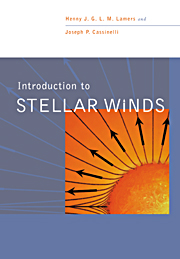38 results
6 - Sound wave driven winds
-
- Book:
- Introduction to Stellar Winds
- Published online:
- 05 June 2012
- Print publication:
- 17 June 1999, pp 128-144
-
- Chapter
- Export citation
9 - Magnetic rotator theory
-
- Book:
- Introduction to Stellar Winds
- Published online:
- 05 June 2012
- Print publication:
- 17 June 1999, pp 255-293
-
- Chapter
- Export citation
Index
-
- Book:
- Introduction to Stellar Winds
- Published online:
- 05 June 2012
- Print publication:
- 17 June 1999, pp 434-438
-
- Chapter
- Export citation
APPENDIX 1 - The chronology of stellar wind studies
-
- Book:
- Introduction to Stellar Winds
- Published online:
- 05 June 2012
- Print publication:
- 17 June 1999, pp 409-415
-
- Chapter
- Export citation
APPENDIX 4 - Physical and astronomical constants
-
- Book:
- Introduction to Stellar Winds
- Published online:
- 05 June 2012
- Print publication:
- 17 June 1999, pp 423-423
-
- Chapter
- Export citation
Object index
-
- Book:
- Introduction to Stellar Winds
- Published online:
- 05 June 2012
- Print publication:
- 17 June 1999, pp 433-433
-
- Chapter
- Export citation
Preface
-
- Book:
- Introduction to Stellar Winds
- Published online:
- 05 June 2012
- Print publication:
- 17 June 1999, pp xi-xiv
-
- Chapter
- Export citation
1 - Historical overview
-
- Book:
- Introduction to Stellar Winds
- Published online:
- 05 June 2012
- Print publication:
- 17 June 1999, pp 1-7
-
- Chapter
- Export citation
Bibliography
-
- Book:
- Introduction to Stellar Winds
- Published online:
- 05 June 2012
- Print publication:
- 17 June 1999, pp 424-432
-
- Chapter
- Export citation
12 - Winds colliding with the interstellar medium
-
- Book:
- Introduction to Stellar Winds
- Published online:
- 05 June 2012
- Print publication:
- 17 June 1999, pp 355-384
-
- Chapter
- Export citation
10 - Alfvén wave driven winds
-
- Book:
- Introduction to Stellar Winds
- Published online:
- 05 June 2012
- Print publication:
- 17 June 1999, pp 294-318
-
- Chapter
- Export citation

Introduction to Stellar Winds
-
- Published online:
- 05 June 2012
- Print publication:
- 17 June 1999
4 - Basic concepts: non-isothermal winds
-
- Book:
- Introduction to Stellar Winds
- Published online:
- 05 June 2012
- Print publication:
- 17 June 1999, pp 92-117
-
- Chapter
- Export citation
Contents
-
- Book:
- Introduction to Stellar Winds
- Published online:
- 05 June 2012
- Print publication:
- 17 June 1999, pp vii-x
-
- Chapter
- Export citation
Frontmatter
-
- Book:
- Introduction to Stellar Winds
- Published online:
- 05 June 2012
- Print publication:
- 17 June 1999, pp i-vi
-
- Chapter
- Export citation
2 - Observations of stellar winds
-
- Book:
- Introduction to Stellar Winds
- Published online:
- 05 June 2012
- Print publication:
- 17 June 1999, pp 8-59
-
- Chapter
- Export citation
5 - Coronal winds
-
- Book:
- Introduction to Stellar Winds
- Published online:
- 05 June 2012
- Print publication:
- 17 June 1999, pp 118-127
-
- Chapter
- Export citation
7 - Dust driven winds
-
- Book:
- Introduction to Stellar Winds
- Published online:
- 05 June 2012
- Print publication:
- 17 June 1999, pp 145-186
-
- Chapter
- Export citation
APPENDIX 3 - De l'Hopital's rule for equations with a singular point
-
- Book:
- Introduction to Stellar Winds
- Published online:
- 05 June 2012
- Print publication:
- 17 June 1999, pp 421-422
-
- Chapter
- Export citation
3 - Basic concepts: isothermal winds
-
- Book:
- Introduction to Stellar Winds
- Published online:
- 05 June 2012
- Print publication:
- 17 June 1999, pp 60-91
-
- Chapter
- Export citation



